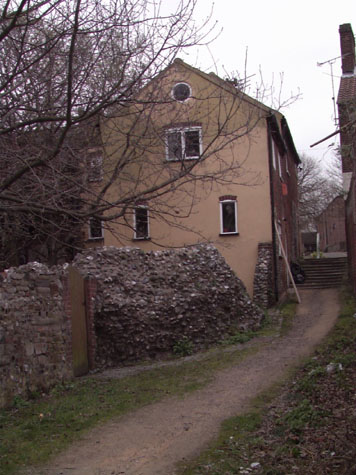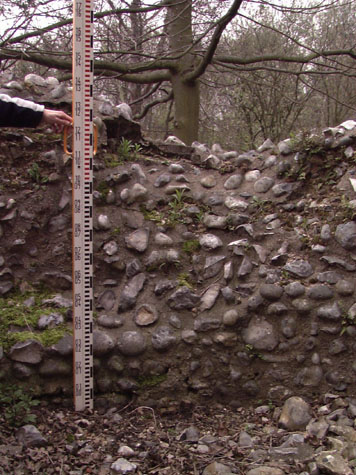|
 [1] The remains of the tower at Oak Street from the west (from the
river bank) with the steps leading up to Oak Street and the site of St
Martin's Gate. In the 14th century the river flowed up to the base of
the tower.
[1] The remains of the tower at Oak Street from the west (from the
river bank) with the steps leading up to Oak Street and the site of St
Martin's Gate. In the 14th century the river flowed up to the base of
the tower.
 [2]The inside of the tower showing how much flint has been lost
from the inner face.
[2]The inside of the tower showing how much flint has been lost
from the inner face.
|
Introduction
St Martin's Gate at the north-west corner
of the defences was on the road into Norwich from Fakenham. It was
set just above the River Wensum at the point where it flows into the city.
In the Middle Ages, the river here was probably relatively wide and marshy
and the road kept to a ridge on the east bank. There was a short length of
wall running down from the gate to the river to close this section of the
defences with a single round tower here, which was originally on the river
bank. The water courses have changed since the Middle Ages and as
the river has been constricted into a tighter channel, the tower is now
set back over 40 metres from the river.
[1] The tower was 15 metres from the site of the
gate and 3 metres lower than the level of the road. [survey
drawing 13-01 Map]. Only the base of the tower survives. The
base is circular, with an external diameter of 6.2 metres and the
surviving part stands to about 2.4 metres above the present ground level.
Most of the flint of the wall face has been lost and there are no
surviving features apart from what appears to be the remains of a loop on
the north-east side which would have looked back along the outer face of
the wall towards St Martin's Gate.
[2] There is some indication that the internal floor level of a lower chamber
survives in part and is just above the present ground level.
A drawing in the Castle Museum dating from
the middle of the 19th century is identified as a view of this tower and
at that stage part of the vaulting of the lower stage survived. There is
no indication from documents or maps of the original height of the
tower ... it is not known if the tower had an upper chamber or just an open
platform at the level of the wall walk protected by a parapet. Nor is
there any evidence in the base of the tower for a staircase. The
upper level of the tower could have been reached from the wall walk itself
rather than from a staircase or steps here.
Part of the wall between the tower and the gate survives in the
basement of the house facing on to Oak Street. [survey
drawing 13-02 Plan]. The house was built on the outer
side of the wall beside the site of the gate and was the Dun Cow Public
House in the 19th century.
|
